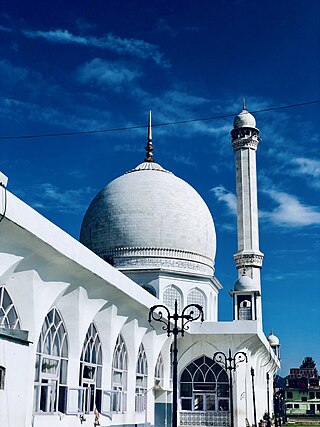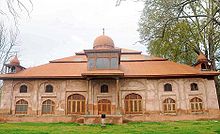
Srinagar is a city in Indian-administered Jammu and Kashmir in the disputed Kashmir region. It is the largest city and summer capital of Jammu and Kashmir, which is an Indian-administered union territory. It lies in the Kashmir Valley along the banks of the Jhelum River, and the shores of Dal Lake and Anchar Lakes, between the Hari Parbat and Shankaracharya hills. The city is known for its natural environment, various gardens, waterfronts and houseboats. It is also known for traditional Kashmiri handicrafts like the Kashmir shawl, papier-mâché, wood carving, carpet weaving, and jewel making, as well as for dried fruits. It is the second-largest metropolitan area in the Himalayas.

The Srinagar District is an administrative district of Indian-administered Jammu and Kashmir in the disputed Kashmir region. It is one of the 20 districts of Jammu and Kashmir. Situated in the centre of the Kashmir Valley, it is the second-most populous district of the union territory after Jammu District as per the 2011 national census, and is home to the summer capital city of Srinagar. Likewise, the city of Srinagar also serves as the Srinagar District's headquarters.

The Eidgah Mosque is one of the oldest mosques in Kabul, Afghanistan. It is located to the southeast of the affluent Wazir Akbar Khan neighborhood, near the Ghazi Stadium and Chaman-e-Hozori. It was built during the late 19th century and early 20th century, when the country was ruled by Emir Abdur Rahman Khan and his son Habibullah Khan. It is now a historical site for tourists to visit.

The Shah Mir dynasty or the House of Shah Mir, was a Kashmiri dynasty that ruled the Kashmir Sultanate in the Indian subcontinent. The dynasty is named after its founder, Shah Mir.

Mirwaiz Mohammad Umar Farooq is the 14th Mirwaiz of Kashmir. He is a Kashmiri separatist political leader. He is also an Islamic religious cleric of Kashmir Valley.

The Hazratbal Shrine, popularly called Dargah Sharif, is a Muslim shrine located in Hazratbal locality of Srinagar in Jammu and Kashmir, India. It contains a relic, Moi-e-Muqqadas, believed to be the hair of the Islamic prophet Muhammad. It is situated on the northern bank of the Dal Lake in Srinagar, and is considered to be Kashmir's holiest Muslim shrine.
Mirwaiz is a hereditary institution of head priests that is unique to the Kashmir Valley. The traditional role of mirwaizes is to provide religious education in the shrines and mosques. Over time, the mirwaizes also took up social, cultural and political activities.

Jamia Masjid is a mosque in Srinagar, Jammu and Kashmir, India. Situated at Nowhatta in the Old City, the Mosque was commissioned by Sultan Sikandar in 1394 CE and completed in 1402 CE, at the behest of Mir Mohammad Hamadani, son of Mir Sayyid Ali Hamadani, and is regarded as one of the most important mosques in Kashmir. The mosque is located downtown, a central zone in the religio-political life in Srinagar. Thronged by Muslims every Friday, it is a prime tourist attractions of Srinagar.

Ghiyath al-Din Shah Rukh Shahi Khan, commonly known as Zayn al-Abidin the Great, was the ninth sultan of the Kashmir Sultanate, ruling first from 1418 to 1419 and then from 1420 to 1470. He was famously called Budshah by his subjects.

Mir Sayyid Ali Hamadani was a Sufi Muslim saint of the Kubrawiya order, who played an important role in spread of Islam in the Kashmir Valley of northern India. He was born in Hamadan, Iran and preached Islam in Central Asia and South Asia. He died in Swat on his way from Srinagar to Mecca and was buried in Khatlan, Tajikistan in 1385 CE, aged 71–72. Hamadani was also addressed honorifically throughout his life as the Shāh-e-Hamadān, Amīr-i Kabīr, and Ali Sani.

Eidgah or Idgah, also Eid Gah or Id Gah is a term used in South Asian Islamic culture for the open-air enclosure usually outside the city reserved for Eid prayers offered in the morning of Eid al-Fitr and Eid al-Adha. It is usually a public place that is not used for prayers at other times of the year. On the day of Eid, the first thing Muslims do in the morning is gather usually at a large open ground and offer special prayers, in accordance with the Sunnah. Although the usage of the term Eidgah is of Indian origin, it may be used for the musalla, the open space outside a mosque, or other open grounds where Eid prayers are performed, due to the lack of a specific Islamic term for a site of Eid observance. The Eidgah is mentioned in the famous Bengali poem by Kazi Nazrul Islam, O Mon Romzaner Oi Rozar Sheshe.

The Dhanmondi Shahi Eidgah, also known as Mughal Eidgah, is located in Saat Masjid road, in Dhanmondi residential area of Dhaka, Bangladesh. The Eidgah was built in 1640 CE during the Mughal era and has been in use for Eid celebration since then.
Achabal is the village in Baramulla district, Jammu and Kashmir |Jammu and Kashmir. It is around 5 km (3.1 mi) away from Sopore town. The village is surrounded by the villages of like Lorihama, Alsafa Colony, Ladoora and Ferozpora. This village is accessible by the National Highway from Ferozpora-Achabal link road which connects it to Handwara, Kupwara and other northern regions of Kashmir. It is also accessible by Ladoora-Sopore road. There is a branch of Jammu & Kashmir Bank in the main market.

Aali Mosque or Ali Mosque is a mosque located in the Srinagar city of Jammu and Kashmir, India. It was Built by Sultan Ali Shah in 1395 AD, who was the elder brother of Sultan Zain al-Abidin (Budshah) and named after Sultan Ali Shah himself..It is also believed to have been constructed in 1471 AD during the reign of Shamiri king Sultan Hassan Shah and named after Sayyid Ali Hamadani (Shah Hamdan). The structure is the largest existing mosque within the premises of Eidgah Srinagar, which is also named after Sayyid Ali Hamadani. It is also the second largest mosque in the Kashmir Valley after the Jamia Masjid, also located in Srinagar. The building shows a unique synthesis between Central Asian and local traditions of wooden architecture. The mosque is based on a 4m×4m grid supported on 5 m 151 wooden columns of 0.95 m girth. The main hall on the ground floor measuring 61.2 m by 20.5 m consists of 75 such modules. All 151 deodar columns are rested on carved stone pedestals with varying designs. The overall area of the mosque is 1844 m2.
Downtown, popularly known as Shahar-e-Khaas, is the largest and the most densely populated area of the city of Srinagar in the union territory of Jammu and Kashmir, India. The area is mostly located on the banks of Jhelum river about five km (3.1 mi) from city center. The area is considered as the core point in the city as the first inhabitants of the Srinagar lived there. In general, the whole area to the north of city centre Lal Chowk is considered a part of downtown although some areas hold high significance. The Jamia Masjid, Srinagar and many other shrines are located here, which makes it the central spiritual, religious, political and moral center of whole Kashmir.

Khanqah-e-Moula, also known as Shah-e-Hamadan Masjid and Khanqah, is a mosque located in the Old City of Srinagar in Jammu and Kashmir, India. Situated on the right bank of the river Jhelum between the Fateh Kadal and Zaina Kadal bridges, it was built in 1395 CE, commissioned by Sultan Sikendar in memory of Mir Sayyid Ali Hamadani. It is held to be the first Khanqah—mosques associated with specific saints—in the Kashmir valley. It is one of the best examples of Kashmiri wooden architecture, and is decorated with papier mache.

Jamiat Ahle Hadith Jammu and Kashmir is an Islamic Ahl-i Hadith organization based in Srinagar, in Indian-administrated Jammu and Kashmir. The main motive of the organisation is to practice and propagate the Ahl-i Hadith movement. The organization has lakhs of followers across Kashmir.

The Aasar-i-Shareef Pethmakhama, popularly called Ziyarat Makhama, is a Muslim shrine located in Pethmakhama, Magam, Budgam, Jammu and Kashmir, India. It contains a relic, Moi-e-Muqqadas, which is widely believed to be the hair of the Islamic prophet Muhammad. It is situated at Pethmakhama which is nearest to Magam Town of Budgam District and is considered to be one of the Kashmir's holiest Muslim shrine.
Maulana Masroor Abbas Ansari is a Kashmiri religious and political leader, scholar, cleric, preacher, activist and theologian in Jammu and Kashmir. He is the Chairman of Jammu & Kashmir Ittihadul Muslimeen (JKIM), a Kashmiri nationalist Shia separatist political party that aims for Shi'a–Sunni unity in Kashmir and is also a religious organization that conducts the Grand Ashura Procession in Kashmir. He is the President of Al-Abbas Relief Trust, Karan Nagar, Srinagar, and a Senior leader of All Parties Hurriyat Conference (APHC), an alliance of 26 political, social, and religious organizations formed on 9 March 1993 as a united political front to unite Jammu and Kashmir. He is also a senior leader of Jammu Kashmir Liberation Front (JKLF). He succeeded his father Mohammad Abbas Ansari after his death. Ansari is a religious leader of Kashmiri Shia Muslims, chairman of the Jammu & Kashmir Ittihadul Muslimeen, and Senior Leader of the All Parties Hurriyat Conference.(JKLF).
















